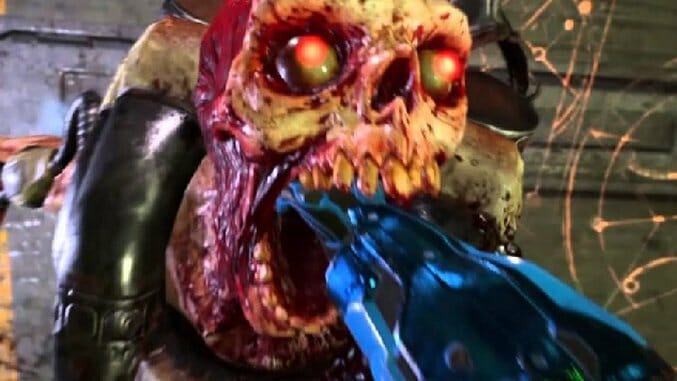
I like it when heads explode. That is, in videogames. DOOM has been out for a few weeks now and I’m still geeking out over how awesome it is to rip a giant pit monster’s face off or punch through a demon’s chest.
For all the talk about violence in games being bad, we sure do seem to enjoy it. And why not? There’s something about the cathartic headrush of a gory execution or a precision headshot that is almost erotic. Instead of violence, let’s turn our attention to things in videogames that are even more egregious. Grab hold of your pearls.
1. Enemies who don’t pass the Turing test
I get it. The point of a game is to make the player feel powerful. And who doesn’t like feeling like the entire population of a gameworld lives and dies by your caprice? But the challenge of game design is to balance the ludic objectives with narrative and theme.
For all the talk of “immersion” (whatever the hell that actually means) we keep seeing games with boilerplate, nondescript enemies that are as numerous and generic as they are naive and stupid. Retracing the same route over and over again, giving up the search for a deadly secret agent after a few seconds (every time I hear a guard say “I guess I was hearing something” I die a little inside)—few things break the hallowed “immersion” (whatever the hell that actually means) more than the realization that somebody is letting you win.
2. Lazy writing
Writing is hard. Any writer (including and especially present company) can tell you that. It may seem straightforward to write for a videogame, but when you take into account everything, from the plot to the loading screen blurbs to the enemy barks, it can get out of hand. I understand. But please, at least try. Hearing the same three or four barks recycled among countless enemies and friendly characters makes me wish someone would shoot me in the knee with an arrow.
3. Loading screen mixed messages
Loading screens are like intrusive body scans at the airport: We’re all annoyed they’re there, but they’re also not going anywhere any time soon. Packing loading screens with game hints, flavor text, or even historical quotes is a way to make that slightly less irritating—sort of like having a really cute TSA agent rooting through your luggage.
The problem is this: Do you want me to read your loading screens or not? I can’t count the number of times I’ve tuned out the blurb about the Ancient History of the Realm of Fantastica and then looked back just in time to catch an essential gameplay or mechanical hint fading from view. Either don’t put essential information on your loading screens, or only put essential information there. The player needs to be able to prioritize their attention.
4. Supporting problematic ideals
Yes, this is the part where I talk about how shitty games are to women, people of color, ethnic minorities, the LGBTQ community, and basically anyone else who doesn’t have a dirty blonde crewcut and an assault rifle. Complaining about mass murder in videogames is like complaining that the straps are too tight on your electric chair. The issue isn’t that you’re killing people, it’s that players are killing a specific group of people. Games like Call of Duty may seem apolitical but a series built on the corpses of thousands of dead virtual Arab men sends one hell of a message.
It’s not just “lol whoops” oversight either—in a lot of cases it seems like developers go out of their way to get some of this stuff wrong. One example made famous by comedian Kumail Nanjiani highlights that the multiplayer map “Karachi” in Modern Warfare 2 features street signs written in Arabic, despite Pakistan (where Karachi is located) being a primarily Urdu-speaking country. What could have been a three-second Google search instead turned into yet another in a long list of videogame microaggressions.
5. Bloat
Picture this: You’re invited to a dinner party. You eat a delicious meal. Afterward, you’re treated to dessert, which you eat because even though that steak was really good, you don’t want to be rude, and besides, ice cream is delicious. Then they bring out a cheese plate. And some port. And peanut butter sandwiches, which don’t even make sense with the rest of the meal but there they are anyway.
It seems game designers have been the ones hosting these dinner parties, and it shows through in many modern design conventions. A short, direct book is heralded as being succinct, to the point, and efficient, but a short direct game is panned as being “incomplete.” So we stuff our games with meaningless collectibles, huge open maps that are largely uninteresting, ubiquitous “data logs,” bonus weapons, achievements, and a variety of other OCD-inducing busywork we tolerate because we think it means we’re playing a better game. Spoilers: You’re not. With games, as with people, gaudy, trumped up appearances are a surefire sign that there is virtually nothing of substance lurking beneath the gold lamé and the expensive-looking costume jewelry.
Violence is bad. In a world soaked with it from large-scale gun violence down to physical scuffles at political rallies, it makes sense that we take a wary view of lionizing brutality in our entertainment. But a little head-knocking is fine every now and then. It’s poor design conventions and toxic ideals that have begun to infiltrate our games on a quieter and more insidious level that we should really start to fear. But don’t take my word for it. After all, I’m just over here, standing knee-deep in the dead.
Patrick Lindsey is a Boston-based game critic who likes to focus on narrative and thematic design. In addition to cohosting the Indie Megacast and Bullet Points podcasts, he also co-edited SHOOTER, an ebook anthology of critical essays on shooting games. Follow him on Twitter @HanFreakinSolo.